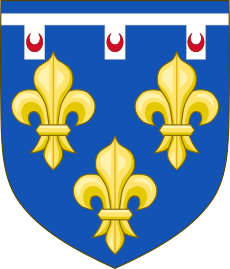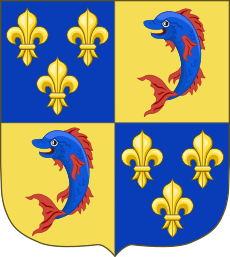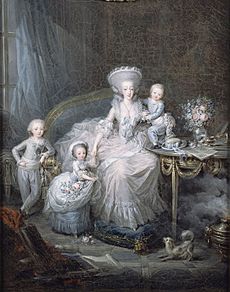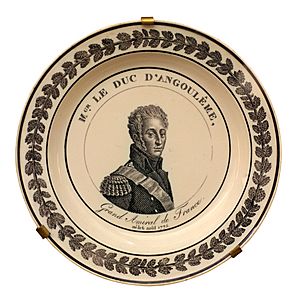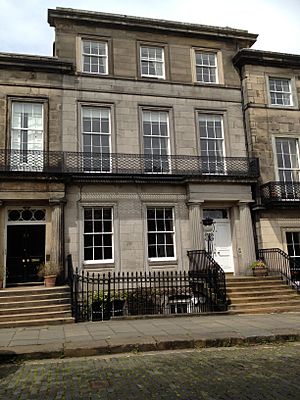Louis Antoine, Duke of Angoulême facts for kids
Quick facts for kids Louis Antoine |
|
|---|---|
| Dauphin of France Duke of Angoulême |
|
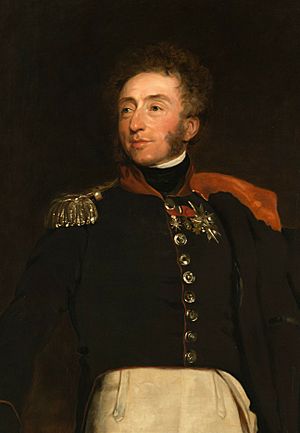
Portrait by William Corden the Elder after the full length portrait by Sir Thomas Lawrence
|
|
| Legitimist pretender to the French throne | |
| Reign | 6 November 1836 – 3 June 1844 (reign when king of France) 2 August 1830 |
| Predecessor | Charles X |
| Successor | Henry V |
| Born | 6 August 1775 Palace of Versailles, Kingdom of France |
| Died | 3 June 1844 (aged 68) Gorizia, Austrian Empire |
| Burial | Kostanjevica Monastery, Nova Gorica, Slovenia |
| Spouse | |
| House | Bourbon |
| Father | Charles X |
| Mother | Marie Thérèse of Savoie |
| Religion | Roman Catholicism |
| Signature | |
Louis Antoine of France, Duke of Angoulême (born August 6, 1775 – died June 3, 1844) was the oldest son of Charles X of France. He was the last Dauphin of France from 1824 to 1830. A Dauphin was the title given to the person who was next in line to become King of France.
For a very short time, less than 20 minutes, he was considered King of France and Navarre. This happened when his father gave up the throne during the July Revolution in 1830. However, Louis Antoine also quickly gave up his claim to the throne. He never truly ruled the country. After his father died in 1836, he was seen by a group called the Legitimists as the rightful king, known as Louis XIX. Legitimists were people who believed that the oldest male heir should always be the king.
When he was born, Louis Antoine was called a petit-fils de France, which means "grandson of France." He was first known as Louis Antoine d'Artois. When his father became king, Louis Antoine became the Dauphin of France. His last name then changed to "de France," which was a tradition for princes of his rank.
Contents
Louis Antoine's Early Life
Louis Antoine was born at the Palace of Versailles. He was the oldest son of Charles Philippe, who was the Count of Artois. Charles Philippe was the youngest brother of King Louis XVI of France. Louis Antoine's mother was Princess Maria Theresa of Savoy, also known as Marie Thérèse in France.
From 1780 to 1789, Louis Antoine and his younger brother, Charles Ferdinand, were taught by their governor, Armand-Louis de Sérent. They studied at the château de Beauregard, which was close to Versailles.
When the French Revolution started in 1789, the two young princes had to leave France with their father. They went to Turin, then Germany, and finally England.
In 1792, Louis Antoine joined the army of his cousin, the Prince of Condé. This army was made up of émigrés, which were people who had fled France during the revolution.
In June 1795, his uncle, the comte de Provence, declared himself King Louis XVIII. Later that year, Louis Antoine, who was 20 years old, led a royalist uprising in the Vendée. This was a rebellion that supported the king. It was not successful.
In early 1797, he joined his brother and uncle in Germany. They hoped to join the Austrian Army. But Austria was defeated by France, so they had to flee again. They found safety in Mittau, Courland, under the protection of Tsar Paul I of Russia. A Tsar was the ruler of Russia.
While there, on June 10, 1799, he married his first cousin, Marie Thérèse of France. She was the oldest child of Louis XVI and Marie Antoinette. Marie Thérèse was the only member of the royal family to survive the French Revolution. They did not have any children.
Military Career and Exile
In April 1800, Louis Antoine became the leader of a cavalry regiment in the Bavarian army. He fought in the Battle of Hohenlinden against the French. He showed good skills as a military leader.
In early 1801, Tsar Paul made peace with Bonaparte. Because of this, the French royal family in exile had to move to Warsaw, which was controlled by Prussia. For the next ten years, Louis Antoine stayed with and advised his uncle, Louis XVIII.
They returned to Russia when Alexander I became Tsar. But in mid-1807, a treaty between Napoleon and Alexander forced them to seek safety in Britain. There, at Hartwell House, King Louis set up his court again. Louis Antoine was given money to live on. Twice he tried to go back to Russia to fight against Napoleon, but the Tsar did not allow it.
He stayed in Britain until 1814. Then he sailed to Bordeaux, a city in France that had declared its support for the King. His arrival in Bordeaux on March 12, 1814, was seen as the start of the Bourbon restoration. This was when the Bourbon royal family returned to power in France. From there, Louis Antoine fought alongside the Duke of Wellington to help defeat Napoleon.
Louis Antoine could not stop Napoleon from returning to Paris during the "Hundred Days." This was a period when Napoleon briefly returned to power after escaping exile. Louis Antoine was forced to flee to Britain again. He faithfully served Louis XVIII after Napoleon's final defeat at Waterloo.
In 1823, he led a French army into Spain. The goal was to help the Spanish King regain his absolute powers, meaning full control. This event was known as the Hundred Thousand Sons of Saint Louis. Louis Antoine won the Battle of Trocadero. After this victory, King Ferdinand VII of Spain was able to firmly restore his power. For this success, Louis Antoine was given the title of a Prince of Trocadero.
When the King died in 1824, Louis Antoine's father became King Charles X. Louis Antoine then became the Dauphin of France, meaning he was next in line to the throne. He supported his father's policies, which aimed to undo the changes from the French Revolution. He even removed former imperial officers from the army.
The July Revolution and Final Exile
In July 1830, many angry people demanded that Charles X and his family give up the throne. This event became known as the July Revolution. The people wanted his cousin, Louis Philippe, Duke of Orléans, to become king instead. A group of people went to the Tuileries Palace to make Charles X agree.
Charles X reluctantly signed the document giving up his throne on August 2, 1830. It is said that Louis Antoine spent the next 20 minutes listening to his wife, who begged him not to sign a similar document. Meanwhile, the former King Charles X was crying. However, Louis Antoine also gave up his claim to the throne. He did so in favor of his nephew, the Duke of Bordeaux.
For the last time, Louis Antoine left France to live in exile. He was known as the "Count of Marnes" during this time. He never returned to France.
In November 1830, Louis Antoine and his wife traveled to Edinburgh, Scotland. They lived in a house at 21 (now 22) Regent Terrace, close to Holyrood Palace, where Charles X was staying.
In 1832, Emperor Francis I of Austria offered the Prague Castle in Prague to the royal family. So, Louis Antoine and Charles X moved there. However, Francis I died in 1835. His successor, Ferdinand I of Austria, told the French royal family that he needed the palace for his own coronation in the summer of 1836.
The exiled French kings and their group then left Prague. They eventually arrived at the palace of Grafenberg in Görz, Austria (now Gorizia, Italy) on October 21, 1836.
Many legitimists did not believe that the abdications were valid. They continued to recognize Charles X as king until he died in 1836. After Charles X's death, they believed Louis Antoine became King Louis XIX.
Louis Antoine died in Görz in 1844, when he was 68 years old. He was buried in the same crypt as his father, Charles X. This crypt is in the church of the Franciscan monastery of Kostanjevica in Nova Gorica, Slovenia. After Louis Antoine's death, his nephew, the Duke of Bordeaux, became the head of the royal family of France. He was known as Henry V, but he used the title of Count of Chambord while in exile.
Louis Antoine in Fiction and Film
A very young Louis Antoine is shown by an uncredited child actor in a short scene in the movie Marie Antoinette. This scene has a small mistake. It incorrectly says his parents were Louis XVIII and Marie Josephine Louise of Savoy, who never had children.
See also
 In Spanish: Luis Antonio de Francia para niños
In Spanish: Luis Antonio de Francia para niños
- List of shortest-reigning monarchs
- Duc d'Angoulême's porcelain factory


